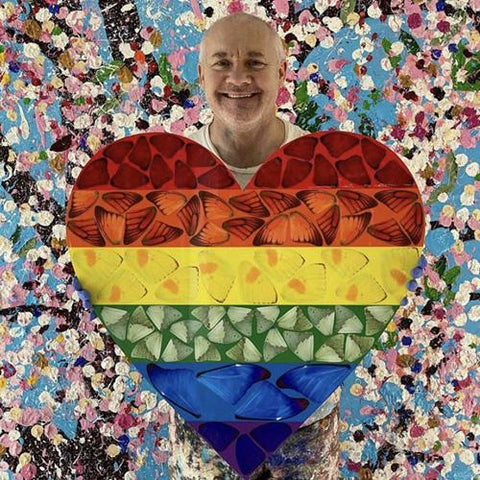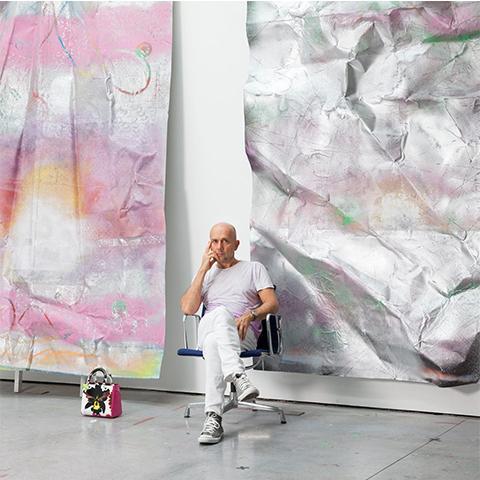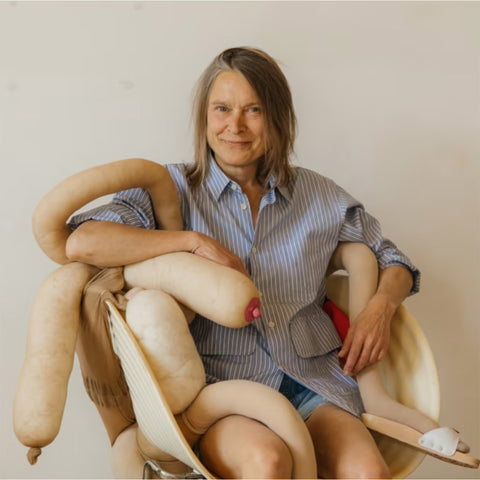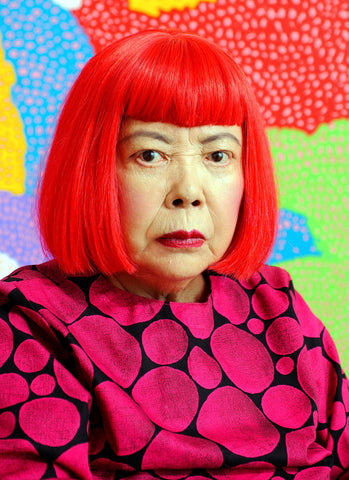On Saturday 20th April, the Venice Biennale opens its doors, marking its 60th year as the world’s oldest and most prestigious international art exhibition.
The Biennale brings together prominent artists from all corners of the world, with controversy guaranteed, and many a new household name birthed onto the international scene.
In today’s blog, we’re revealing a little more about what 2024’s Venice Biennale has in store, and taking a look at what Enter Gallery’s artists got up to when they were invited…well, most of them, anyway!

Strangers Everywhere
Each year, the Venice Biennale has a theme, chosen by the event’s curator, which this year is Adriano Pedrosa – an esteemed Brazilian curator with a reputation for elevating unheard voices.
Pedrosa’s theme for 2024 is ‘Stranieri Ovunque’, which translates to ‘foreigners everywhere’. Via his theme, Pedrosa calls us to reflect on how we are all foreigners, and to remind us of how displacement, exile and marginality affect us all.
Art Biennale 2024 is highlighting artists who are immigrants, expatriates, and refugees, queer artists who have moved between sexualities and genders, and indigenous artists who are often treated as foreigners in their own land.
The British Pavilion
Representing Britain this year is artist and filmmaker, John Akomfrah – a Ghanaian-born artist known for exploring racial injustice, migrant identity and climate breakdown.
 John Akomfrah. Photograph: David Levene for the Guardian
John Akomfrah. Photograph: David Levene for the Guardian
While we haven’t been able to dig up any details about what to expect from Akomfrah’s stint in the prestigious British Pavilion, his is one of the most anticipated national exhibitions at the Biennale.
Recently knighted, and a huge inspiration for multiple generations of artists in the UK and beyond, his is sure to be a show stopper. Plus, he’ll be wanting to dazzle since his close friend, Sonia Boyce, won the exhibition’s top prize, the Golden Lion, in 2022.
Now that you know what to expect from 2024, let’s take a look back at some of Enter Gallery’s artists who have made waves at the Venice Biennale…
Damien Hirst, 1993 and 2017
Of course, Damien Hirst, one of the Young British Artists and the bad boy of the art world, has made it over to Venice, and true to form, he’s outraged the Catholic Church and left critics baffled on more than one occasion.
Hirst’s first turn in The Floating City was back in 1993, when he offered his own take on the portraits of Madonna and Christ Child that decorate the Italian city, debuting his Mother and Child (Divided) sculpture.
 © Damien Hirst and Science Ltd.
© Damien Hirst and Science Ltd.
This notorious piece features a mother cow and calf, cut in half, and suspended in formaldehyde in separate display cases. While it created a storm of critique, Hirst’s artwork went on to win him the Turner Prize in 1995.
Hirst returned in 2017, much to the chagrin of Italian animal right protestors, who let him know exactly what they thought of him by dumping 40 kilogrammes of animal excrement on the doorstep of his exhibition, along with a banner stating, “Damien Hirst Go Home! Check Out This Work of Art! 100% Animalisti.”
Hydra and Kali by Damien Hirst, April 6, 2017. Photo: Miguel Medina/AFP/Getty Images.
Hirst’s 2017 exhibition, Treasures from the Wreck of the Unbelievable, was held across two venues in Venice, and is considered one of his most ambitious shows yet. Ten years in the making, and reportedly costing him £5 million of his own money, the show was based on a (made-up) tale of a 1st century slave who, once freed, amassed a fortune and built an incredible collection of art and artefacts. According to Hirst, these priceless items were lost at sea, but were dredged up from the deep specifically for his show.
The 190-piece exhibition comprised enormous barnacle-covered sculptures of mythical characters, from Cyclops and sea monsters, to Mermaids and Mickey Mouse. A couple even resembled Hirst.

The show divided critics with Hirst accused of cultural appropriation, and one reviewer calling it, “undoubtedly one of the worst exhibitions of contemporary art staged in the past decade.”
Of course, Hirst didn’t bat an eyelid…70 percent of the artworks sold right away, and he’d made multiple versions of many of the sculptures, which he was selling for between $500,000 to $5 million.
View artworks by Damien Hirst.
Tracey Emin, 2007
Tracey Emin made history in 2007, becoming only the second solo female artist to exhibit at the British Pavilion. Emin described her show, Borrowed Light, as her, “most feminine body of work so far, very sensual but at the same time…graphically sharp. It is both pretty and hardcore.”

Photo by David Levene
Emin’s show provided shock factor, but rather than being for the brash style of work associated with her YBA days in pieces like Everyone I’ve Ever Slept With (1995) and My Bed (1998), the surprise came in the exhibit’s gentle intimacy. Some critics even declared it might be a sign that Emin had, ‘finally grown up.’
Via smudgy monoprints, love poems cast in neon, and a series called Abortion Watercolours, Emin let us into her life with, describing, “how it feels to be a body taken over by feeling; exhilarating, frightening, embarrassing, confusing, disabling and empowering.”
Sarah Lucas, 2015
While Emin went subtle, her old pal, Sarah Lucas, relied on the sharp humour and distinctive bawdiness that has defined her illustrious career.
Lucas’s 2015 stint in the British Pavilion with her show, I SCREAM DADDIO, was all about pleasure and perversion with room after room of sculptures depicting the kinds of things we get up to when no one’s watching.

©Sarah Lucas, photo captured by Christian Sinibaldi courtesy of the Guardian.
At the entrance to the Pavilion, Lucas placed a reclining male nude, in a nod to revered British sculptors whose works have been displayed in the same space. Her interpretation, entitled Gold Cup Maradona, welcomed visitors to the show with a nine-foot erection, that guaranteed it conveyed it was happy to see them.
 Gold Cup Maradona, by Sarah Lucas. Photograph: Christian Sinibaldi
Gold Cup Maradona, by Sarah Lucas. Photograph: Christian Sinibaldi
When asked about the show, Lucas famously declared, ‘No one’s told me off about the fannies yet!’ Of course, she was referring to her now infamous plaster casts of female legs, each animated via interplay with domestic furniture. Captured bending over desks, squatting over toilet seats, or lying on kitchen tables, these naked forms were accentuated with suggestively placed cigarettes as amusing cherries on top.
Speaking of dessert, Lucas’s rendered her entire exhibition, from the walls to the sculptures, in a garish custard yellow, to put visitors in a good mood by reminding them of their favourite puddings.
Marc Quinn, 2013 and 2022
Another YBA to take Venice by storm, causing his fair share of controversy along the way, was Marc Quinn.
In 2012, Quinn presented a solo exhibition at the Venice Biennale exploring the relationship between art and science, and the human body as a survival mechanism. The talking point of the show was Breath - a 36-foot high inflatable sculpture depicting Alison Lapper, an artist with Phocomelia, at eight-months pregnant. Quinn described the piece as representing, ‘a new model of female heroism’.

Of course, this nudity angered the Patriarch of Venice, who was less than pleased about the artwork’s placement obscuring the façade of Palladio’s church of St. Giorgio Maggiore – one of Venice’s most historic Catholic churches.
Nevertheless, Quinn returned to Venice in 2022 with his divisive and somewhat kitsch show, HISTORYNOW, which featured screenshots taken during lockdown reinterpreted as paintings.
On phone-shaped canvases, Quinn captured news headlines starring the likes of Britney and Beyoncé, magazine covers and news stories about the storming of the Capitol, and the war in Ukraine.

SHAMAN TRIPTYCH, 2020, Courtesy of Marc Quinn
Quinn’s show took place in in the National Archaeological Museum in Venice. Each of his 48 new artworks were placed in dialogue with the museums classic sculptures, urging the visitor to consider what elements of our history deserve preservation.
Honourable Mentions…
Yayoi Kusama, 1966
When Japanese artist, Yayoi Kusama was just starting out, she famously moved to New York in 1958, and marched into each of the city’s most prestigious art galleries demanding representation. Her direct approach worked, and her career took off as a result.
In 1966, at age 37, Kusama took on the Venice Biennale in a similarly direct fashion, making an unofficial entry with Narcissus Garden – a sculptural installation comprising 1,500 shiny orbs placed on the ground goadingly close to the Italian Pavilion.

Yayoi Kusama with “Narcissus Garden” (1966) installed in Venice Biennale, Italy, 1966© YAYOI KUSAMA. Courtesy David Zwirner, New York; Ota Fine Arts
As part of the exhibit, Kusama donned a golden kimono and stood amongst the orbs, selling them to willing buyers for just two dollars apiece.
The police soon got involved, and Kusama was expelled from the Biennale. Narcissus Garden however, went on to become one of her most well-known pieces, and has been exhibited more than 40 times over the past five and a half decades. Kusama didn’t return to Italy until 1993.
View artworks by Yayoi Kusama.
Banksy, 2019
Clearly drawing inspiration from Kusama, Banksy also made an unofficial appearance in 2019. The enigmatic street artist announced his presence over Instagram, showing footage of him setting up a market stall, along with the caption: “Despite being the largest and most prestigious art event in the world, for some reason, I’ve never been invited.”

Banksy’s market stall featured several paintings, which when placed side-by-side revealed a larger image of one of the mammoth cruise ships known to plague and pollute Venice’s beautiful canals. In his signature tongue-in-cheek fashion, the stall was advertised with a sign declaring, ‘Venice in Oil’.
While in town, Banksy also painted The Migrant Child on the wall of an abandoned Venetian palace. The piece, depicting a child in a life jacket, holding a flare, served as a commentary on the global refugee crisis.

Migrant Child (2019), by British street artist Banksy in Venice. VINCENZO PINTO/AFP VIA GETTY IMAGES
Over the years since, the artwork has understandably faded, placed as it is at the waterline of one of Venice’s busiest canals. The issue of whether or not to preserve the artwork has been a point of contention, with some fighting to have it moved or restored to ensure it remains a tourist attraction, and others claiming that leaving it to fade away is the right thing to do. Knowing Banksy, and how people’s rabid reactions to his art often become part of the artwork, we’re guessing this was his plan all along.
The 60th Venice Biennale runs from April 20th until November 24th 2024. Sign up to our newsletter to hear more news from the art world straight o your inbox.








